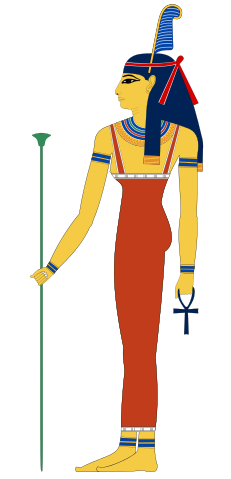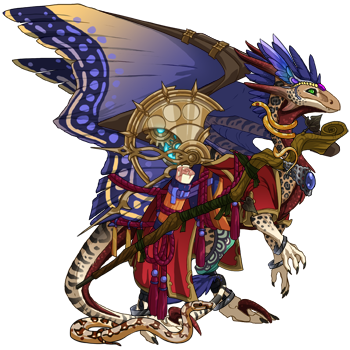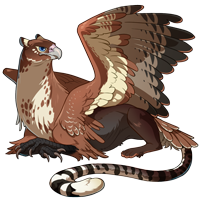

Maat
(#34226221)
The Lawgiver: Daughter of the Progens
Click or tap to view this dragon in Predict Morphology.
Energy: 49
out of
50

Expand the dragon details section.
Collapse the dragon details section.
Personal Style
Apparel











Skin
Effect
Scene

Measurements
Length
6.09 m
Wingspan
4.73 m
Weight
651.43 kg
Genetics
Tan
Jaguar
Jaguar
Iris
Spinner
Spinner
Blood
Glimmer
Glimmer
Hatchday
Breed
Eye Type
Level 5 Wildclaw
EXP: 106 / 5545




STR
22
AGI
10
DEF
10
QCK
15
INT
8
VIT
10
MND
8
Biography

|
As I was scrying her, I figured out that her colour scheme was a diluted replication of the colours Maat is depicted wearing. She is thus named after the daughter of Re and the Egyptian Goddess of Truth and Justice. So far she's the only derg with her colours across the ENTIRE SITE, so I'm pretty proud ;v; A CONTESTANT FOR CUQUOISE'S PROGEN HATCHLING CONTEST that ran around July/August 2017. |
As the only daughter of the progens within the Lair of Many References NOT to be exalted to the Gladekeeper, Maat has dedicated her life to upholding the Lair's Justice System as a tribute to her exalted siblings. Setting the laws that TLOMR’s colony is held to, Maat is the one responsible for overseeing the daily running of the Lair. She bears little resentment towards the deity or her parents, but she is stalwart in her belief that she was left in the Lair for a reason, and this was only amplified once she was granted a transmutation scroll and made a Wildclaw. She is also the one in charge of sending the exalted to the Behemoth.
It was Maat who campaigned for Alduin to be locked up with no communication, and thus she will be one of his first targets if ever he is freed. In her spare time, when not reading up about Lair lore, Maat can be seen taking combat lessions from the Lair's most fearsome ridgeback warrior: Larimar. Maat has a close relationship with her mother, Eurydice, and the latter is VERY protective of her daughter. Both Juniper and Eurydice take pride in what their child has become, and will continue to be proud to the very end.
OLD LOOK = Fae: Triple Basic

COMPLETED: 11th August 2017 (WC scroll purchase)

Curious Claws Adopt by MawkishMuse
To the Egyptian mind, Maat bound all things together in an indestructible unity: the universe, the natural world, the state, and the individual were all seen as parts of the wider order generated by Maat.
In Law, Maat was the spirit in which justice was applied rather than the detailed legalistic exposition of rules, and represented the normal and basic values that formed the backdrop for the application of justice that had to be carried out in the spirit of truth and fairness. From the 5th dynasty (c. 2510-2370 BCE) onwards the Vizier responsible for justice was called the Priest of Maat and in later periods judges wore images of Maat.
Later scholars and philosophers also would embody concepts from the wisdom literature, or Sebayt. These spiritual texts dealt with common social or professional situations and how each was best to be resolved or addressed in the spirit of Maat.
(Summarised from Wikipedia)
The ceremony of judgment of the dead (called the “Judgment of Osiris,” named for Osiris, the god of the dead) was believed to focus upon the weighing of the heart of the deceased in a scale balanced by Maat (or her hieroglyph, the ostrich feather), as a test of conformity to proper values.
(Encyclopedia Britannica)

COMPLETED: 11th August 2017 (WC scroll purchase)

Curious Claws Adopt by MawkishMuse

|
Maat or Ma'at (Egyptian mˤ3t) refers to both the ancient Egyptian concepts of truth, balance, order, harmony, law, morality, and justice, and the personification of these concepts as a goddess regulating the stars, seasons, and the actions of both mortals and the deities, who set the order of the universe from chaos at the moment of creation. Her ideological counterpart was Isfet. Maat represents the ethical and moral principle that every Egyptian citizen was expected to follow throughout their daily lives. They were expected to act with honor and truth in manners that involve family, the community, the nation, the environment, and the gods. Maat as a principle was formed to meet the complex needs of the emergent Egyptian state that embraced diverse peoples with conflicting interests. The development of such rules sought to avert chaos and it became the basis of Egyptian law. From an early period the King would describe himself as the "Lord of Maat" who decreed with his mouth the Maat he conceived in his heart. The significance of Maat developed to the point that it embraced all aspects of existence, including the basic equilibrium of the universe, the relationship between constituent parts, the cycle of the seasons, heavenly movements, religious observations and fair dealings, honesty and truthfulness in social interactions. The ancient Egyptians had a deep conviction of an underlying holiness and unity within the universe. Cosmic harmony was achieved by correct public and ritual life. Any disturbance in cosmic harmony could have consequences for the individual as well as the state. An impious King could bring about famine or blasphemy blindness to an individual. In opposition to the right order expressed in the concept of Maat is the concept of Isfet: chaos, lies and violence. |
In Law, Maat was the spirit in which justice was applied rather than the detailed legalistic exposition of rules, and represented the normal and basic values that formed the backdrop for the application of justice that had to be carried out in the spirit of truth and fairness. From the 5th dynasty (c. 2510-2370 BCE) onwards the Vizier responsible for justice was called the Priest of Maat and in later periods judges wore images of Maat.
Later scholars and philosophers also would embody concepts from the wisdom literature, or Sebayt. These spiritual texts dealt with common social or professional situations and how each was best to be resolved or addressed in the spirit of Maat.
(Summarised from Wikipedia)
The ceremony of judgment of the dead (called the “Judgment of Osiris,” named for Osiris, the god of the dead) was believed to focus upon the weighing of the heart of the deceased in a scale balanced by Maat (or her hieroglyph, the ostrich feather), as a test of conformity to proper values.
(Encyclopedia Britannica)
Click or tap a food type to individually feed this dragon only. The other dragons in your lair will not have their energy replenished.
This dragon doesn't eat Insects.
Feed this dragon Meat.
This dragon doesn't eat Seafood.
This dragon doesn't eat Plants.
Exalting Maat to the service of the Gladekeeper will remove them from your lair forever. They will leave behind a small sum of riches that they have accumulated. This action is irreversible.
Do you wish to continue?
- Names must be longer than 2 characters.
- Names must be no longer than 16 characters.
- Names can only contain letters.
- Names must be no longer than 16 characters.
- Names can only contain letters.












